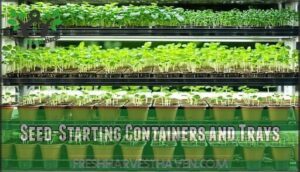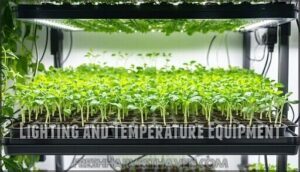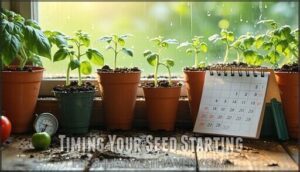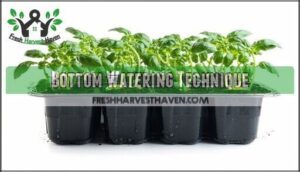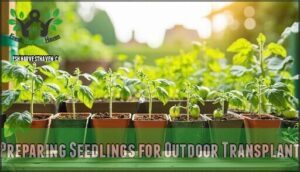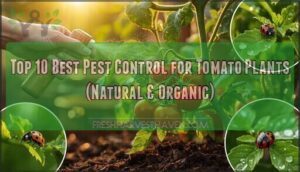This site is supported by our readers. We may earn a commission, at no cost to you, if you purchase through links.
 You can master growing tomatoes from seed indoors by starting 6-8 weeks before your last frost date. Plant seeds ¼ inch deep in sterile soil mix and keep them at 70-85°F.
You can master growing tomatoes from seed indoors by starting 6-8 weeks before your last frost date. Plant seeds ¼ inch deep in sterile soil mix and keep them at 70-85°F.
Your seedlings need 14-16 hours of light daily from grow lights. Use bottom watering to prevent root rot and handle seedlings by their leaves, not stems. When they develop true leaves, thin and transplant them.
The hardening off process takes 7-14 days before moving outdoors. This method gives you access to thousands of varieties you’ll never find in stores, plus stronger plants that’ll reward you with impressive harvests once you know the insider tricks that separate success from disappointment.
Table Of Contents
- Key Takeaways
- Choosing The Best Tomato Seeds
- Essential Supplies for Indoor Seed Starting
- Planting Tomato Seeds Indoors Step by Step
- Caring for Tomato Seedlings Indoors
- Preparing Seedlings for Outdoor Transplant
- Frequently Asked Questions (FAQs)
- How long does it take tomato seeds to grow indoors?
- Why put baking soda around tomato plants?
- How to grow tomatoes from seeds for beginners?
- How many tomato seeds do you put in each hole?
- When should I start fertilizing tomato seedlings?
- How do I prevent common indoor tomato pests?
- What temperature range is ideal for mature plants?
- How often should I prune indoor tomato plants?
- Can I save seeds from homegrown tomatoes?
- How often should I fertilize tomato seedlings?
- Conclusion
Key Takeaways
- You’ll start seeds 6-8 weeks before your last frost date and plant them ¼ inch deep in sterile soil mix at 70-85°F for best germination rates.
- Your seedlings need 14-16 hours of daily light from grow lights positioned 4 inches away, plus bottom watering to prevent root rot and damping-off disease.
- You’ll thin weak seedlings when true leaves appear, then transplant survivors to individual 3-4 inch pots using gentle leaf handling instead of touching stems.
- You must harden off seedlings gradually over 7-14 days with increasing sun exposure before transplanting outdoors when night temperatures stay above 55°F.
Choosing The Best Tomato Seeds
You’ll want to pick seeds that match your growing conditions and taste preferences since the right variety makes all the difference in your success.
Focus on disease-resistant varieties and check seed packets for freshness dates to help guarantee strong germination rates.
Selecting Tomato Varieties
When choosing tomato varieties for indoor growing, you’ll face three key decisions that’ll shape your entire harvest. Determinate vs indeterminate types matter most indoors—compact determinates like Red Robin stay manageable while indeterminates need serious space.
- Heirloom tomatoes offer delightful flavor profiles but may lack disease resistance
- Hybrid choices provide consistent yields and stronger disease tolerance
- Seed varieties like Micro Tom excel in small spaces with 8-12 inch heights
With over 10,000 options, selecting tomato varieties can feel overwhelming. Smart variety selection sets you up for success from day one.
Inspecting Seed Quality and Viability
Once you’ve picked your varieties, examine each seed carefully. Good seeds look plump and uniform without cracks or discoloration.
Test germination by placing ten seeds on damp paper towels—if fewer than seven sprout within two weeks, find fresher stock.
Check packets for recent harvest dates since tomato seeds stay viable for three to four years when stored properly.
Skip any seeds showing white fuzzy mold or coming from questionable sources.
Choosing Disease-Resistant Seeds
Quality seeds mean better plants, and disease-resistant varieties save you heartache later. Look for seed certification that guarantees genetic resistance against common tomato problems.
Hybrid vigor often provides stronger disease prevention than heirloom tomatoes, though both have merit. Check labels for resistance codes like V, F, or N.
These organic options handle disease pressure naturally, making seed propagation easier. Smart choosing tomato varieties includes pest and disease control from day one.
Essential Supplies for Indoor Seed Starting
Getting your tomato seeds to sprout into strong seedlings takes the right setup from the start.
Quality containers, sterile soil mix, and proper lighting equipment will make all the difference in those first crucial weeks.
Seed-Starting Containers and Trays
The containers you choose can make or break your seed starting success. Without proper drainage holes, your seedlings will drown in soggy soil.
Clean old containers work great as long as you punch holes in the bottom. Going with biodegradable pots saves you the transplant hassle later, and remember that bigger containers give roots more room to grow strong.
- Cell packs – Perfect individual spaces for each precious tomato seed
- Peat pots – Biodegradable containers that plant directly into soil
- Plastic trays – Reusable workhorses for multiple growing seasons
- Yogurt cups – Budget-friendly option with drainage holes added
Sterile Seed-Starting Mix
The right seed-starting mix can mean the difference between thriving seedlings and total failure. Regular potting soil is your enemy here – it’s dense, stays too wet, and comes loaded with fungi that cause damping-off disease.
Go with sterile seed-starting mixes instead. These have the fine texture seeds need to germinate properly, plus they hold moisture without getting soggy. Look for peat-based blends or coconut coir mixed with perlite for drainage.
Lighting and Temperature Equipment
Two essential components make or break your indoor tomato journey: proper lighting and controlled heat. LED grow lights positioned within 4 inches of seedlings deliver the red-blue light spectrum tomatoes crave. Tomato seedlings thrive with a PPFD between 250-300.
Pair them with a seedling heat mat controlled by thermostats to maintain that sweet spot of 70-80°F germination temperature. Add humidity domes for moisture control, and you’ve got the perfect nursery setup.
Planting Tomato Seeds Indoors Step by Step
Now you’re ready to plant those tomato seeds and watch them grow into strong seedlings.
The next three steps will walk you through timing, proper planting depth, and the best watering method to get your seeds off to a great start.
Timing Your Seed Starting
Successfully growing tomato seeds hinges on perfect timing. Count back six to eight weeks from your last frost date to find your ideal starting window.
Getting your tomato seeds started comes down to timing it right. Work backwards six to eight weeks from your area’s last frost date—that’s your sweet spot for planting.
Where you live makes a difference. Warmer climates don’t need as much lead time as colder spots. Jump the gun too early and you’ll end up with weak, spindly seedlings that struggle later.
Double-check your local frost dates first. Tomatoes are picky about temperature, so there’s no point rushing things.
Planting Seeds at The Correct Depth
Plant your tomato seeds about ¼ inch deep in quality soil. Seed depth importance can’t be understated – too shallow and they’ll dry out, too deep and they won’t sprout. Use your finger or pencil as depth planting tools.
Seed size matters less than consistent depth. Press gently to help guarantee good soil contact for proper seed germination and starting success.
Bottom Watering Technique
After planting your seeds, ditch the overhead sprinkler approach. Bottom watering allows plants to uptake the water they need and evenly distribute it to their roots, while improving water uptake efficiency.
Place seed trays in shallow water dishes to achieve consistent moisture delivery without disturbing delicate seeds. This prevents root rot by avoiding soil saturation levels that suffocate roots, enhancing nutrient absorption for healthier indoor gardening results.
Caring for Tomato Seedlings Indoors
Once your tomato seeds sprout, you’ll need to give them the right care to grow strong and healthy.
After your tomato seeds pop up, they’ll need proper attention to develop into sturdy, healthy plants.
Your seedlings need bright light, warm (not soggy) soil, and you’ll want to know the right time to transplant them into larger containers.
Providing Adequate Light and Water
Your seedlings need consistent light and moisture to thrive. LED grow lights should run 14-16 hours daily, providing the full light spectrum your plants crave. Check soil moisture by inserting your finger an inch deep—water when it feels dry. Bottom watering prevents overwatering and maintains proper humidity control around your delicate seedlings.
- Watch your seedlings stretch toward the light like enthusiastic students reaching for knowledge
- Feel the satisfaction of perfectly moist soil that crumbles just right between your fingers
- Celebrate those first true leaves emerging—your green babies are growing strong
Maintaining Optimal Soil Temperature
Your seedlings crave consistent warmth like a cozy blanket. Soil thermometers help you monitor temperature, while heating mats deliver steady heat for ideal seed germination.
Keep soil temperature between 70–85°F using a seedling heat mat with thermostat control. This temperature consistency prevents germinating delays and ensures vigorous growth.
Monitor ambient temperature and soil moisture together for best results.
Thinning and Transplanting Seedlings
When your tomato seedlings develop their first true leaves, it’s time for thinning and transplanting. High seedling density leads to weak plants competing for light and nutrients.
- Gently lift seedlings by their cotyledon leaves, never the stem
- Transplant into individual 3-4 inch pots with fresh potting mix
- Water carefully to prevent transplant shock and encourage root development
- Space plants adequately to promote healthy growth and air circulation
This potting up process strengthens your growing tomato seedlings for outdoor success.
Preparing Seedlings for Outdoor Transplant
You’ve nurtured your tomato seedlings indoors for weeks, but they can’t handle the shock of moving straight from your cozy house to the harsh outdoor world.
Sure, you’ve babied those tomato seedlings for weeks indoors, but toss them straight outside and they’ll wilt faster than you can say "garden failure."
Hardening Off Tomato Seedlings
Before throwing your tomato seedlings into the great outdoors, you’ll need gradual acclimation over 7-14 days. Start with 2-3 hours of sun exposure in a sheltered spot, increasing daily.
Reduce watering during hardening to toughen them up. Wind protection is key—strong gusts can snap tender stems.
Temperature control matters too; wait until nights stay above 50°F consistently before beginning this essential seedling care step.
Transplanting to Larger Pots or Garden Beds
After hardening off, your seedlings are ready for their new homes. Choose quality potting mix for container transplanting or prepare garden beds with compost.
Handle seedlings gently by their leaves, never stems. Transplant when soil warms and night temperatures stay above 55°F.
Space plants 18-24 inches apart to prevent rootbound conditions and promote healthy growth.
Supporting Continued Growth and Health
Once your tomatoes are settled in their new home, focus on nutrient management and structural framework. Apply diluted liquid fertilizer weekly to fuel vegetative growth.
Watch for early pest control needs like aphids or whiteflies. Disease prevention starts with proper spacing and air circulation.
Environmental factors like consistent watering and mulching foster healthy seedling development. Your plant growth depends on these fundamentals working together.
Frequently Asked Questions (FAQs)
How long does it take tomato seeds to grow indoors?
Before smartphones made everything instant, you’d wait patiently for nature’s timeline. Your tomato seeds usually germinate in 5-10 days, then grow into transplant-ready seedlings in 6-8 weeks indoors.
Long before we got used to instant everything, gardening meant accepting nature’s pace.
Tomato seeds take their sweet time – about 5-10 days to sprout, then another 6-8 weeks growing indoors before they’re ready to transplant.
Why put baking soda around tomato plants?
Baking soda creates an alkaline environment around your plants that helps prevent fungal diseases like blight and powdery mildew.
You’ll sprinkle it lightly around the base to raise soil pH naturally.
How to grow tomatoes from seeds for beginners?
Like nurturing a baby, you’ll start tomato seeds indoors 6-8 weeks before your last frost. Plant seeds in warm, moist soil, provide bright light, and transplant outdoors after hardening off.
Start your tomato seeds indoors about 6-8 weeks before the last frost hits your area. Give them warm, moist soil and plenty of bright light.
Once they’re strong enough and you’ve gradually introduced them to outdoor conditions, you can transplant them to your garden.
How many tomato seeds do you put in each hole?
Plant two to three seeds per hole when starting indoors. This gives you backup options if some don’t germinate.
Once they sprout, you’ll thin out the weaker seedlings, keeping only the strongest one.
When should I start fertilizing tomato seedlings?
Ninety percent of tomato seedling failures stem from poor nutrition timing.
You should start fertilizing your tomato seedlings once they develop their first true leaves, usually 10-14 days after germination. Use a diluted liquid fertilizer weekly.
How do I prevent common indoor tomato pests?
Keep aphids and spider mites away by checking seedlings weekly, wiping leaves with damp cloth, promoting good air circulation, and using yellow sticky traps near plants.
What temperature range is ideal for mature plants?
Mature tomato plants thrive in temperatures between 65-75°F during the day and 55-65°F at night.
They’ll struggle below 50°F or above 90°F, so you’ll want consistent warmth without extreme heat.
How often should I prune indoor tomato plants?
Indoor tomato pruning depends on variety and growth habits. You’ll usually prune suckers weekly, remove lower leaves monthly, and top plants when they reach your height limit.
Can I save seeds from homegrown tomatoes?
Absolutely, it’s like striking gardening gold! You can definitely save seeds from open-pollinated tomatoes. Just scoop out seeds, ferment them for a few days, then dry and store properly.
How often should I fertilize tomato seedlings?
You’ll want to fertilize those little seedlings once weekly with a diluted liquid fertilizer. Start feeding them when they’ve got their first true leaves showing up.
Conclusion
Mastering growing tomatoes from seed indoors transforms you from a casual gardener into a tomato wizard with legendary harvests! You’ve learned the five essential steps that’ll give you healthier seedlings than any store-bought plant.
Growing tomatoes from seed indoors? It’s one of those skills that separates the weekend gardeners from the people who actually know what they’re doing. Once you nail the five key steps, you’ll get stronger, healthier plants than anything you can buy at the garden center.
Growing tomatoes from seed indoors separates weekend gardeners from people who actually know what they’re doing
Start with quality seeds, get your conditions right, and stick to the process. That hardening-off period might feel tedious, but those tough little seedlings will outperform store-bought plants every time.
Time to grab some seeds and see what you can grow.
- https://farmtojar.com/tips-tomato-pepper-seed-germination/
- https://extension.psu.edu/successful-tomatoes-from-seed/
- https://letpot.com/blogs/hydroponic-plant-growing-knowledge-and-tips/types-of-tomato-to-grow-indoors
- https://www.houzz.com/discussions/2978944/how-many-tomato-seeds-do-you-prefer-to-start-ratio
- https://www.lostcoastplanttherapy.com/blogs/news/growing-tomatoes-indoors

